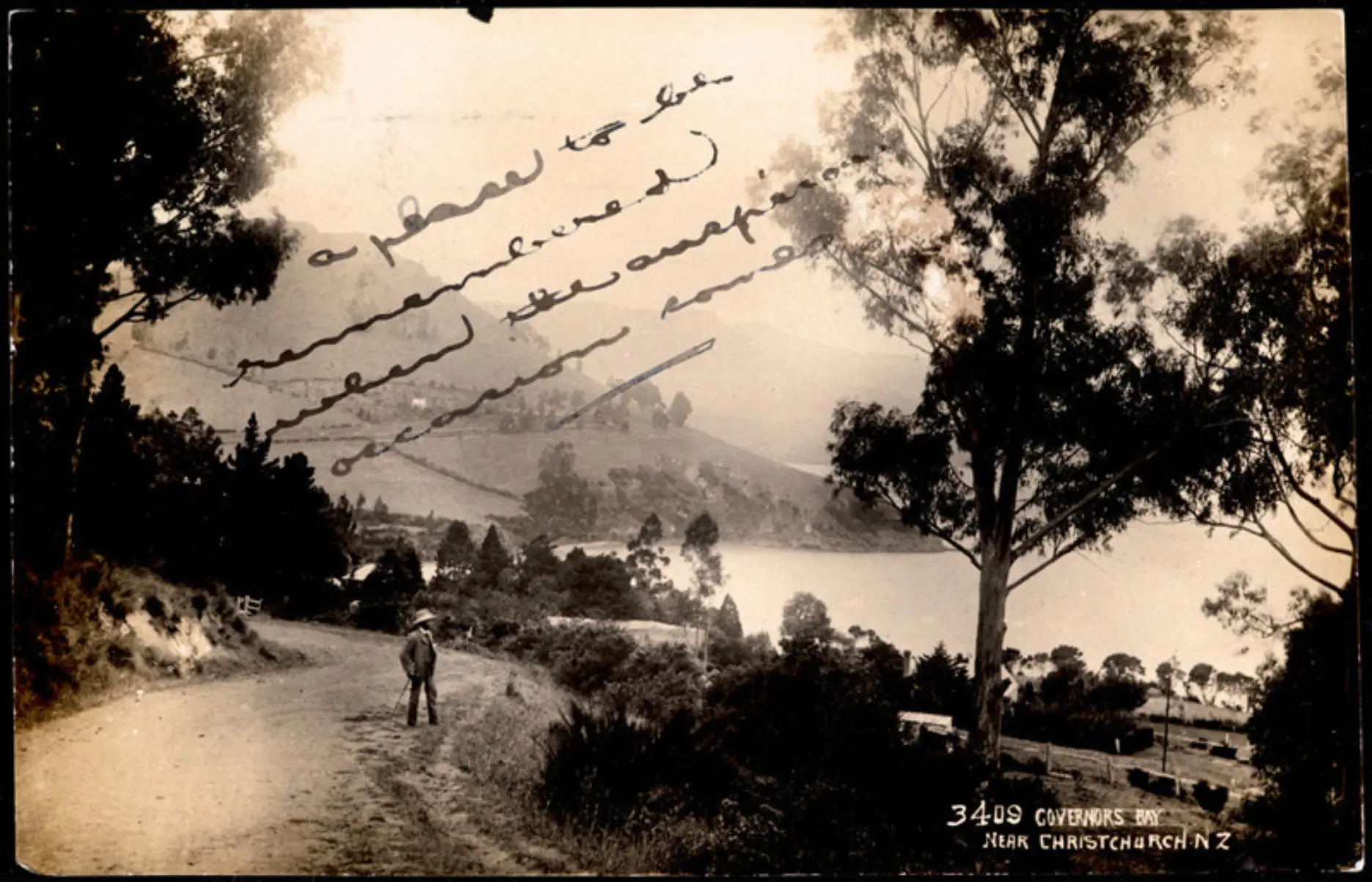PO Box 95
Lyttelton 8841
Te Ūaka recognises Te Hapū o Ngāti Wheke as Mana Whenua and Mana Moana for Te Whakaraupō / Lyttelton Harbour.

View of Governors Bay. Postcard sent on 24th December 1909.
Te Ūaka The Lyttelton Museum ref. 7942.1
https://www.teuaka.org.nz/online-collection/1128107
John Dyer’s Bay
On 10 August 1849 the hotly contested Port Cooper Deed was signed by 18 Ngāi Tahu rangatira and the Government Surveyor Walter Mantell, with the British Crown acquiring 65,000 acres around Whakaraupō Harbour for just £200. The Canterbury Association’s pilgrims followed in quick succession with immigrant ships arriving in Lyttelton port from late 1850 through 1851. Processing through the port town’s immigration barracks, many moved on to the Canterbury Plains beyond the Port Hills, while others took up newly acquired lands around the harbour.
The first Pākehā settlers of what eventually became today’s Governors Bay, were Robert and Mary Harris with their large family, who arrived on 9 June 1851 aboard the Steadfast. Travelling 5 miles around the harbour on the rough walking track out of Lyttelton to their 35 acre allotment, the family initially lived in a cave with bullock skin curtains for shelter as they built their new home.
The Hariss’s were followed in late 1851 by one John Dyer, then just 24 years of age, his 26 year-old sister Mary Ann and their good friend Charles Parsons, 21. These young adventurers arrived in the relative luxury of the second cabin, certainly not economy steerage, aboard the Canterbury Association’s 16th ship, Canterbury, under the capable command of Captain Edwards, on 18 October 1851.
Having pre-purchased 50 acres of land before leaving Britain, John Dyer and his erstwhile companions moved on to their new home where the Lyttelton track met an old Māori track that wound its way up and over Pukeatua (later Dyers Pass) to the plains beyond. Charles purchased the 24 acre lot next door and down to the water’s edge, and together with John and Mary Ann as business partners, they built ‘Parakiraki Stoke Farm’ where the first stone fruit orchards ‐ apricots and plums ‐ were planted in Canterbury.
For the first six months they lived in tents as they built the earliest sections of the historic Waitahuna Homestead, where they lived together for the next three years of hard toil on the farm. When Charles and Mary Ann married on April 25 1855, John moved out and built his own sod house further up the hill. With the success of their orchard enterprise, John also bought a sweeping section of land where the Governors Bay School now stands and all the way down to the water, and thus it was that this place also came to be known as Dyer’s Bay.
As many more settlers arrived to farm the area, Whakaraupō quickly became the orchard and market garden for the growing population in Christchurch city. In 1856 the Canterbury Provincial Council provided funds for the construction of a bridle track from Lyttelton out to Dyer’s Bay and environs to cater for the increasing farm traffic. At John Dyer’s instigation, the Council also provided for a survey of the historic Māori path up and over the pass to the city beyond, with work on the road finally beginning in 1862.
With his local knowledge, Dyer advised the engineers and surveyors on the best routes, and even provided meals for the workers. Once the roads were completed, travellers needed to traverse Stoke Farm for either route. With John Dyer being such an affable chap he would often make a point of greeting wayfarers, and so the cattle road up the hill came to be known as Dyer’s Pass Road, being formally gazetted as such in 1911.
In 1860, St Cuthbert’s church was built at the edge of the growing village that was now more often referred to as Governor's (both with and without the apostrophe) rather than Dyer’s Bay, although the latter appears to have remained in local usage until about 1863. Robert Harris laid the cobblestones for the church’s porch where in 1860 John Dyer married one Miss Elizabeth Frances Gray, newly arrived from Britain.
As the years passed, Mary Ann became well known for her charitable works for the church and parsonage, while Elizabeth gave birth to five children, as Charles and John developed their farm holdings. Crushed between a bullock and a gate in 1872, John Dyer survived this mishap but the hard colonial life on the farm had taken its toll. He died on 6th January 1876, aged just 48 years.
See also ‘Governors Bay, reminiscences of past and present days’ (1935).

